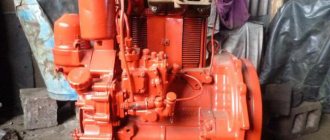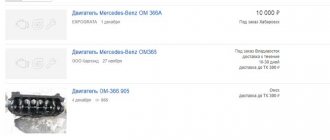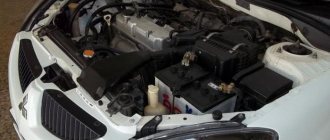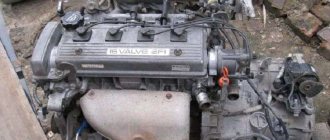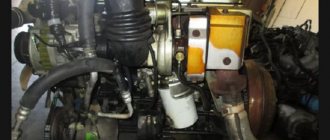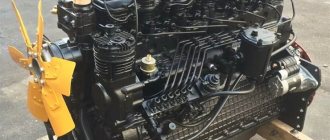The 1MZ-FE engine became the successor to the 3VZ engine, and then was systematically replaced by the 3MZ model. The first MZ is a V-shaped three-liter power unit with six cylinders. The cylinder block is made of aluminum. The angle formed by pairs of cylinders is 60 degrees. 1MZ-FE engines were installed on production cars from 1994 to 2007, and in 1996 this internal combustion engine was recognized as one of the best existing on the market, making it into the top ten top power units.
Toyota 1MZ engine characteristics
Cylinder block of the 1MZ-FE engine: 1 – coolant pump chamber;
2 – tides of knock sensors; 3 – crankshaft bearing cover; 4 – sealing washer; 5 – bolts with tightening torque We suggest that you familiarize yourself with the brief characteristics of the V6 3.0 1MZ-FE engine.
- Release period: 1994-2007;
- Engine type: V-shaped;
- Cylinders: 6;
- Fuel supply type: injection;
- Number of valves per cylinder: 4;
- Volume: 2995 cm3;
- Power indicator (depending on modification): 190 hp. at 5400 rpm, 210 hp. at 5800 rpm;
- Torque indicator (depending on modification): 275 Nm/4400 rpm, 328 Nm/4400 rpm;
- Power unit weight: 158kg;
- Fuel requirements: AI-95 gasoline;
- Required oil type: 5W-30, 10W-30;
- Engine oil volume: 4.7 l;
- Oil change frequency: 10 thousand km (ideally, change the engine oil every 5 thousand km);
- Power unit resource: factory guaranteed - 250 thousand km, in reality - 350 thousand km or more;
Fuel consumption
Lexus ES 4th generation (XV30) was equipped with 1MZ with VVT-I
The level of fuel consumption depends not only on the internal combustion engine itself, but also on the quality of the coating, driving intensity, terrain, speed (the higher the speed, the higher the air flow resistance, and therefore , more energy is required to overcome this resistance), as well as the weather. The technical condition of the machine, the oil used for the engine, and the internal condition of the entire engine system also play an important role.
For example, for the Toyota V6 1MZ-FE engine, not equipped with the VVT-i system, based on Toyota Camry 2001 cars with an automatic gearbox, the gasoline consumption declared by the manufacturer in the urban cycle is 15.7 liters. When driving in highway mode, the engine consumes 8.3 liters per 100 kilometers. Mixed consumption does not exceed 11 liters.
The engine of the 1MZ model, which has a VVT-i gas distribution system, consumes less fuel. Engines used in Lexus ES 300 cars (year of manufacture 2001) with automatic transmission consume 11.2 liters of gasoline in the city, no more than 8.1 liters on the highway, and 9.7 liters in the combined cycle.
Which cars were equipped with the 1MZ engine?
Engines indexed with the 1MZ-FE mark were installed on the following Toyota and Lexus vehicles:
Toyota Avalon in the XX20 body was equipped with a 1MZ engine
- Toyota Avalon, coming out of production lines in Middle East Asia and North America from 1996 to 2004;
- Toyota Windom models, which were produced from 1996 to 2003, and are aimed exclusively at the domestic market;
- Toyota Sienna minivans, which were produced in the South Korean and North American markets in 1998-2000;
- Toyota Camry Solara was equipped with a 1MZ-FE engine from 1999 to 2003 (for coupe and convertible bodies);
- Toyota Estima minivan model, released in 2000 for the domestic Japanese market;
- Toyota Harrier mid-size crossovers produced between 2001 and 2005, aimed at the Japanese market;
- Models of the full-size Toyota Pronard sedan, released in 2000 and aimed at the foreign market;
- Lexus RX300, released between 1999 and 2003 for the American consumer, and from 2003 to 2006 for the Asian and European markets;
Toyota Harrier XU30 (aka Lexus RX)
Design Features
In the first years of production, the 1MZ FE engine had some design features:
- V-shaped internal combustion engine architecture with an angle of 60 degrees between the cylinders;
- aluminum block with dry cylinders made of permanent cast iron liners, cast in place;
- DOHC 12V double cylinder head on each side of the block;
- throttle body with adjustable geometry (double scroll);
- DIS-3 direct ignition system.
Intake manifold
Then some changes were made to the design:
- mounted - fixed geometry receiver with electronic control;
- synchronous ignition system to eliminate signals at the time of release of DIS-6.
In the "type '95" version, the 1MZ FE engine does not have collision between valves and pistons. After installing the VVTi fluid coupling on the intake camshaft, the same engine bends the valves with pistons due to a design change.
Service
The instructions drawn up by the official manufacturer's plant stipulate certain maintenance periods for 1MZ-FE components.
Recommended timing of basic routine maintenance:
- An oil change in 1MZ-FE is required every 10 thousand kilometers.
- The timing belt on 1MZ engines is replaced every 75 thousand km of operation;
Diagram of the valve drive mechanism: 1 – intake valves; 2 – camshaft of the exhaust valve drive; 3 – camshafts driving the intake valves; 4 – camshaft of the exhaust valve drive; 5 – exhaust valves
- The battery life guaranteed by the manufacturer depends on the design features and ranges from 3 to 5 years;
- The coolant in the engine system is replaced after 50 thousand kilometers;
- Air filters need to be replaced at intervals of 1 year, fuel filters - every 30 thousand kilometers of vehicle operation;
- Since the 1MZ-FE power unit system does not provide hydraulic compensators, every 30 thousand it is necessary to adjust the thermal clearances in the valves using washers;
- The exhaust manifold is replaced with a 1MZ at intervals of 70 to 100 thousand kilometers;
- The crankcase ventilation system needs to be cleaned every time the mileage increases by 20 thousand kilometers;
- Spark plugs are changed at intervals of 20 thousand km;
- The thermostat is replaced at 2-year intervals. If signs of malfunction are noticeable, the component is replaced immediately, since any delay can cause engine failure.
Note! Since the timing belt drives the pump, it is recommended to replace these components at the same time to ensure they have the same service life.
1 – toothed pulleys of the gas distribution mechanism; 2 – guide pulley No. 2; 3 – timing belt; 4 – tensioner; 5 – guide pulley
Usage
Power units marked 1MZ-FE were installed on class “E” cars, which include:
- Toyota Camry (V6);
- Toyota Avalon, Toyota Pronard;
- Toyota Windom, Lexus ES 300;
- Toyota Sienna;
- Toyota Solara (V6);
- Harrier, Lexus RX 300;
- Kluger;
- Highlander;
- and minibuses Estima and Alphard.
- Absolutely legal (Article 12.2);
- Hides from photo and video recording;
- Suitable for all cars;
- Works through the cigarette lighter connector;
- Does not cause interference to radios and cell phones.
Find out what the secret is
The 1MZ-FE engine is the first representative in the MZ series - V6 gasoline engines (V-shaped, six-cylinder) produced by Toyota. The engine, like the two subsequent models 2MZ-FE and 3MZ-FE, has a cylinder block and two cylinder heads cast from aluminum alloy, as well as an intake manifold, for lightweight purposes. In each of the heads, according to the design, two cast camshafts (DOHC) are installed, 12 valves (24 valves in total) at the rate of 4 for each cylinder, including 2 for the intake and exhaust. The cylinder camber angle in the block is 60 degrees. The fuel supply system is injection. The piston rings and crankshaft (forged) are made of steel. 1MZ-FE engines were produced with a standard gas distribution system, as well as with a VVT-i variable valve timing system.
The difference between the MZ and VZ series motors is in weight; accordingly, in the former it is reduced due to the aluminum block and lightweight pistons cast from aluminum, which have a molybdenum coating to protect against wear. According to foreign sources, reducing the weight of the MZ series motors did not affect their reliability, including their service life.
I think you will agree with me that the increased weight is not so critical in comparison with the repeated possibility of repairing cylinders in a cast iron block. Aluminum cylinders of MZ series engines are disposable, since the liners pressed into them cannot be replaced or bored, and they do not last forever. After the engine has reached the end of its service life, it can be repaired using the aggregate method, that is, replacing the cylinder block, crankshaft, etc., but this method is very expensive and most likely not cheaper than a contract engine.
Advantages and disadvantages
The main advantage of the 1MZ ICE model is its long service life (more than 350 thousand kilometers), provided by the manufacturer. It is also pleasantly surprising that the characteristics differ in dynamics at any speed. 1MZ modifications not equipped with the VVT-i system do not bend the valves as a result of a broken timing belt. In addition, an undeniable advantage is the fact that engine models that provide phase adjustment are more economical and faster.
Engine lubrication system 1MZ-FE and schematic diagram of the system operation: 1 – oil pump; 2 – pump oil filter; 3 – oil filter
The main problems of the Toyota 1MZ engine are related to the design features of the unit. With long periods of operation, the engine's appetite for oil increases rapidly, so it is important to change caps and rings on time. Knock sensors are unreliable and require frequent replacement. The malfunction of these elements causes the engine to refuse to work or work with obvious difficulties, and traction decreases.
Floating speed in 1MZ engines is often caused by a clogged EGR valve or a broken clutch in the VVT-i valve timing system. Also, the malfunction in many cases is caused by clogged injectors or throttle valves.
Engine cooling system 1MZ-FE and schematic diagram of system operation 1 – coolant pump; 2 – outlet pipe of the cooling system; 3 – bypass channel; 4 – intake manifold; 5 – thermostat; 6 – cylinder block
Toyota 1MZ engines are very sensitive to overheating. An increase in permissible temperatures damages the unit, so it is necessary to carefully monitor the cooling system.
Another obvious disadvantage of the 1MZ from Toyota is the increased formation of carbon deposits, especially in the manifolds.
List of internal combustion engine modifications
During the existence of 1MZ-FE, the internal combustion engine device was modified, but the marking remained the same, so the version with timing adjustments using VVTi couplings can be considered a modification of the engine conditionally. Later, the attachments partially changed - instead of a throttle valve with two scrolls of different lengths, an electronically controlled throttle was used.
Modification 1MZ-FE VVTi
Tuning
One of the easiest ways to increase power levels is to use supercharged tuning. Since this engine model was aimed at the foreign market, KIT kits were produced by Toyota's TRD subsidiary, as well as a number of other manufacturers.
Piston 1MZ: 1 - polymer coating
Toyota 1MZ V6 3.0 internal combustion engine tuning algorithm:
- Installation of an intercooler and installation of a compressor providing a pressure of 0.5 bar;
- Installation of nozzles with a power of 320 - 360cc;
- Modification of the exhaust pipe diameter by 2.5 inches;
- Installation of the appropriate firmware version (adapter required);
Such measures will increase power to 270 horsepower. However, there is also a flip side to the coin, since such modifications not only cost a pretty penny, but also significantly reduce the life of the unit.
Crankshaft 1MZ
The possibilities associated with mechanical tuning are quite limited. This is due to the impossibility of boring the cylinder head channels, as well as the high cost of replacing all camshafts or valves.

